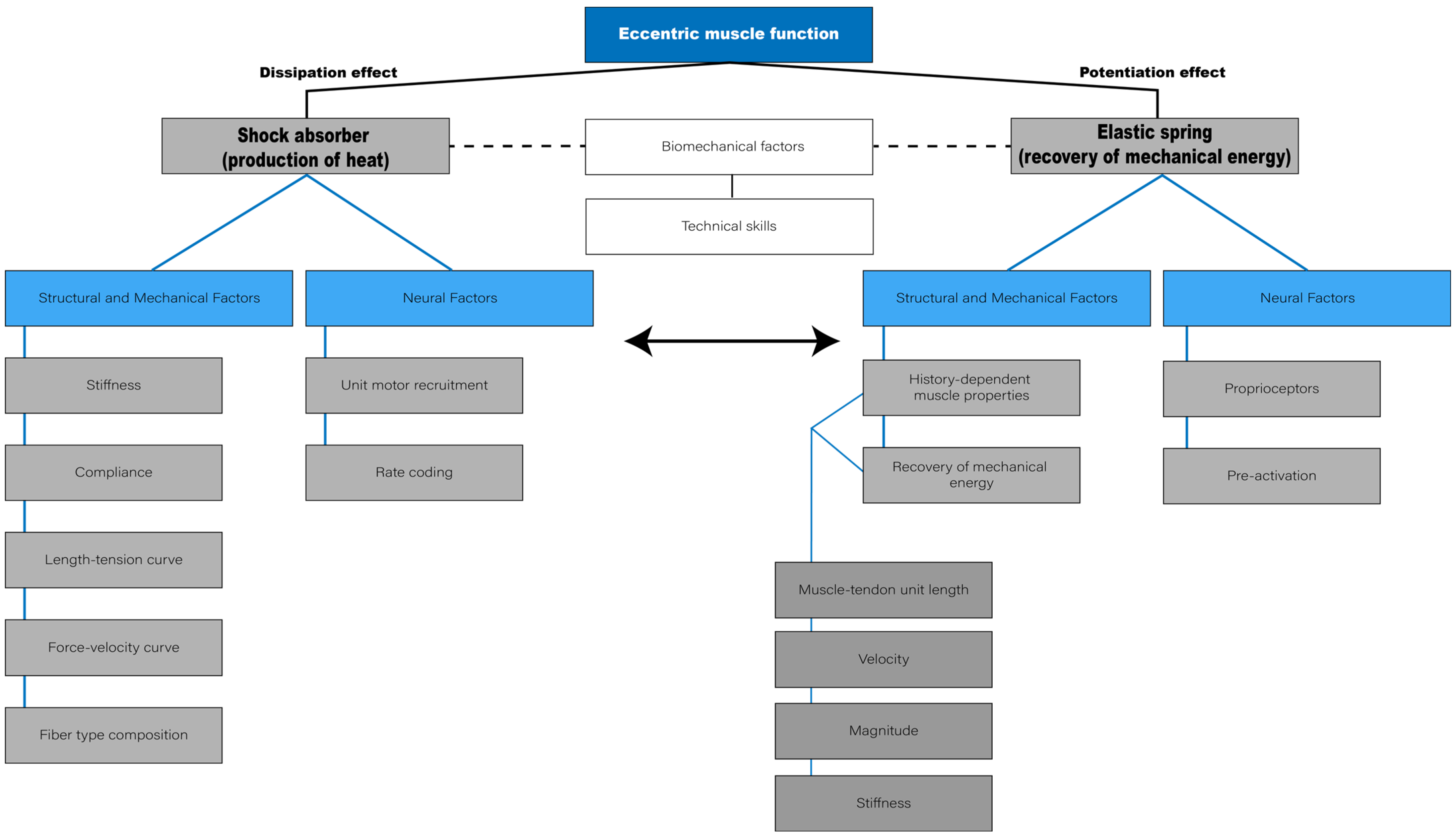Eccentric Resistance Training: A Methodological Proposal of Eccentric Muscle Exercise Classification Based on Exercise Complexity, Training Objectives, Methods, and Intensity
Abstract
:1. Introduction
2. Characteristics, Benefits, and Risks of Eccentric Muscle Action
3. Methods and Purposes of Eccentric Muscle Training
3.1. Types and Classification of Eccentric Exercise
3.2. Determination of Intensity, Volume, Rest, and Frequency of Eccentric Exercises
3.3. Preparation, Execution, and Order of Exercises
3.4. Execution Complexity of Eccentric Exercises
4. Methodological Proposal: Classification, Characteristics, and Examples of the Proposed Eccentric Exercises
4.1. Basic Eccentric Exercise (Table 2)
| Intensity | Body weight, body weight (%) up to 40% of concentric 1RM [30,59], and RPE up to 4. |
| Objective | Sports Rehabilitation and Return to Sport; Injury Prevention; Sporting Performance [59,105]. |
| Examples of exercise complexity | Basic single- and multi-joint human movement skills, low-impact plyometric and shock-absorbing movements, body weight load, and therapeutic exercises. |
4.2. Moderate Eccentric Exercise [33] (Table 3)
| Intensity | Body weight, body weight (%) up 40–60% of concentric 1RM and RPE between 4 and 6. |
| Objective | Sports Rehabilitation and Return to Sport; Injury Prevention; Sporting Performance. |
| Examples of exercise complexity | Basic to medium single and multi-joint, low to medium-impact plyometric and shock-absorbing movements, and balance exercises. |
4.3. Submaximal Eccentric Exercise [115,116] (Table 4)
| Intensity | Body weight, body weight (%) up 60–90% of concentric 1RM and RPE between 6 and 8. |
| Objective | Return to Sport; Muscle Development; Injury Prevention; Sporting Performance. |
| Examples of exercise complexity | Medium to complex single and multi-joint, medium- to high-impact plyometric and shock-absorbing movements, and competitive exercises. |
4.4. Maximal and Supramaximal Eccentric Exercise [60,61,62,116,119] (Table 5)
| Intensity | Body weight, body weight (%) up 90–140% of concentric 1RM and RPE ≥ 8. |
| Objective | Sporting Performance. |
| Examples of exercise complexity | Complex single- and multi-joint high-impact plyometric movements and competitive exercises. |
5. Final Considerations
Author Contributions
Funding
Institutional Review Board Statement
Informed Consent Statement
Data Availability Statement
Conflicts of Interest
References
- Lindstedt, S.L. Skeletal muscle tissue in movement and health: Positives and negatives. J. Exp. Biol. 2016, 219, 183–188. [Google Scholar] [CrossRef] [PubMed] [Green Version]
- Smith, T.B.; Hopkins, W.G. Variability and predictability of finals times of elite rowers. Med. Sci. Sports Exerc. 2011, 43, 2155–2160. [Google Scholar] [CrossRef] [PubMed]
- Suchomel, T.J.; Wagle, J.P.; Douglas, J.; Taber, C.B.; Harden, M.; Haff, G.G.; Stone, M.H. Implementing Eccentric Resistance Training—Part 1: A Brief Review of Existing Methods. J. Funct. Morphol. Kinesiol. 2019, 4, 38. [Google Scholar] [CrossRef] [PubMed] [Green Version]
- Vogt, M.; Hoppeler, H.H. Eccentric exercise: Mechanisms and effects when used as training regime or training adjunct. J. Appl. Physiol. 2014, 116, 1446–1454. [Google Scholar] [CrossRef] [PubMed] [Green Version]
- Devita, P.; Skelly, W.A. Effect of landing stiffness on joint kinetics and energetics in the lower extremity. Med. Sci. Sports Exerc. 1992, 24, 108–115. [Google Scholar] [CrossRef] [PubMed] [Green Version]
- McNitt-Gray, J.L. Kinetics of the lower extremities during drop landings from three heights. J. Biomech. 1993, 26, 1037–1046. [Google Scholar] [CrossRef]
- Mkaouer, B.; Akkari-Ghazouani, H.; Amara, S.; Bouguezzi, R.; Jemni, M.; Chaabene, H. Kinetic and Kinematic Analysis of Landing during Standing Back Somersault Using Three Technical Arm Swings in Artistic Gymnastics. J. Funct. Morphol. Kinesiol. 2023, 8, 10. [Google Scholar] [CrossRef] [PubMed]
- Prilutsky, B. Eccentric Muscle Action in Sport and Exercise. Biomech. Sport Perform. Enhanc. Inj. Prev. 2005, 56–86. [Google Scholar] [CrossRef]
- McBurnie, A.J.; Harper, D.J.; Jones, P.A.; Dos’Santos, T. Deceleration Training in Team Sports: Another Potential ‘Vaccine’ for Sports-Related Injury? Sports Med. 2022, 52, 1–12. [Google Scholar] [CrossRef]
- Seiberl, W.; Hahn, D.; Power, G.A.; Fletcher, J.R.; Siebert, T. Editorial: The Stretch-Shortening Cycle of Active Muscle and Muscle-Tendon Complex: What, Why and How It Increases Muscle Performance? Front. Physiol. 2021, 12, 693141. [Google Scholar] [CrossRef]
- Davies, G.; Riemann, B.L.; Manske, R. Current Concepts of Plyometric Exercise. Int. J. Sports Phys. Ther. 2015, 10, 760–786. [Google Scholar]
- Turner, A.N.; Jeffreys, I. The Stretch-Shortening Cycle: Proposed Mechanisms and Methods for Enhancement. Strength Cond. J. 2010, 32, 87–99. [Google Scholar] [CrossRef] [Green Version]
- Hoppeler, H. Moderate Load Eccentric Exercise; A Distinct Novel Training Modality. Front. Physiol. 2016, 7, 483. [Google Scholar] [CrossRef] [PubMed] [Green Version]
- Herzog, W. The multiple roles of titin in muscle contraction and force production. Biophys. Rev. 2018, 10, 1187–1199. [Google Scholar] [CrossRef] [PubMed]
- Stotz, A.; Maghames, E.; Mason, J.; Groll, A.; Zech, A. Maximum isometric torque at individually-adjusted joint angles exceeds eccentric and concentric torque in lower extremity joint actions. BMC Sports Sci. Med. Rehabil. 2022, 14, 13. [Google Scholar] [CrossRef]
- Peñailillo, L.; Blazevich, A.; Nosaka, K. Energy expenditure and substrate oxidation during and after eccentric cycling. Eur. J. Appl. Physiol. 2014, 114, 805–814. [Google Scholar] [CrossRef]
- Peñailillo, L.; Blazevich, A.J.; Nosaka, K. Factors c of eccentric compared with concentric cycling. J. Appl. Physiol. 2017, 123, 884–893. [Google Scholar] [CrossRef]
- Mike, J.; Kerksick, C.M.; Kravitz, L. How to Incorporate Eccentric Training Into a Resistance Training Program. Strength Cond. J. 2015, 37, 5–17. [Google Scholar] [CrossRef] [Green Version]
- Tinwala, F.; Cronin, J.; Haemmerle, E.; Ross, A. Eccentric Strength Training: A Review of the Available Technology. Strength Cond. J. 2017, 39, 32–47. [Google Scholar] [CrossRef]
- Gérard, R.; Gojon, L.; Decleve, P.; Van Cant, J. The Effects of Eccentric Training on Biceps Femoris Architecture and Strength: A Systematic Review with Meta-Analysis. J. Athl. Train. 2020, 55, 501–514. [Google Scholar] [CrossRef] [Green Version]
- Franchi, M.V.; Reeves, N.D.; Narici, M.V. Skeletal Muscle Remodeling in Response to Eccentric vs. Concentric Loading: Morphological, Molecular, and Metabolic Adaptations. Front. Physiol. 2017, 8, 447. [Google Scholar] [CrossRef] [PubMed] [Green Version]
- Pincheira, P.A.; Boswell, M.A.; Franchi, M.V.; Delp, S.L.; Lichtwark, G.A. Biceps femoris long head sarcomere and fascicle length adaptations after 3 weeks of eccentric exercise training. J. Sport Health Sci. 2022, 11, 43–49. [Google Scholar] [CrossRef]
- Waggett, A.D.; Ralphs, J.R.; Kwan, A.P.; Woodnutt, D.; Benjamin, M. Characterization of collagens and proteoglycans at the insertion of the human Achilles tendon. Matrix Biol. J. Int. Soc. Matrix Biol. 1998, 16, 457–470. [Google Scholar] [CrossRef]
- Kumka, M.; Bonar, J. Fascia: A morphological description and classification system based on a literature review. J. Can. Chiropr. Assoc. 2012, 56, 179–191. [Google Scholar]
- Roberts, T.J. Contribution of elastic tissues to the mechanics and energetics of muscle function during movement. J. Exp. Biol. 2016, 219, 266–275. [Google Scholar] [CrossRef] [PubMed] [Green Version]
- de Hoyo, M.; Sañudo, B.; Carrasco, L.; Mateo-Cortes, J.; Domínguez-Cobo, S.; Fernandes, O.; Del Ojo, J.J.; Gonzalo-Skok, O. Effects of 10-week eccentric overload training on kinetic parameters during change of direction in football players. J. Sports Sci. 2016, 34, 1380–1387. [Google Scholar] [CrossRef]
- Beato, M.; Dello Iacono, A. Implementing Flywheel (Isoinertial) Exercise in Strength Training: Current Evidence, Practical Recommendations, and Future Directions. Front. Physiol. 2020, 11, 569. [Google Scholar] [CrossRef] [PubMed]
- Suarez-Arrones, L.; Saez de Villarreal, E.; Núñez, F.J.; Di Salvo, V.; Petri, C.; Buccolini, A.; Maldonado, R.A.; Torreno, N.; Mendez-Villanueva, A. In-season eccentric-overload training in elite soccer players: Effects on body composition, strength and sprint performance. PLoS ONE 2018, 13, e0205332. [Google Scholar] [CrossRef]
- Aagaard, P. The Use of Eccentric Strength Training to Enhance Maximal Muscle Strength, Explosive Force (RDF) and Muscular Power-Consequences for Athletic Performance. Open Sports Sci. J. 2010, 3, 52–55. [Google Scholar] [CrossRef]
- Murtaugh, B.; Ihm, J.M. Eccentric training for the treatment of tendinopathies. Curr. Sports Med. Rep. 2013, 12, 175–182. [Google Scholar] [CrossRef] [Green Version]
- Jayaseelan, D.J.; Mischke, J.J.; Strazzulla, R.L. Eccentric Exercise for Achilles Tendinopathy: A Narrative Review and Clinical Decision-Making Considerations. J. Funct. Morphol. Kinesiol. 2019, 4, 34. [Google Scholar] [CrossRef] [PubMed] [Green Version]
- Harris-Love, M.O.; Seamon, B.A.; Gonzales, T.I.; Hernandez, H.J.; Pennington, D.; Hoover, B.M. Eccentric Exercise Program Design: A Periodization Model for Rehabilitation Applications. Front. Physiol. 2017, 8, 112. [Google Scholar] [CrossRef] [PubMed] [Green Version]
- Quinlan, J.I.; Franchi, M.V.; Gharahdaghi, N.; Badiali, F.; Francis, S.; Hale, A.; Phillips, B.E.; Szewczyk, N.; Greenhaff, P.L.; Smith, K.; et al. Muscle and tendon adaptations to moderate load eccentric vs. concentric resistance exercise in young and older males. GeroScience 2021, 43, 1567–1584. [Google Scholar] [CrossRef] [PubMed]
- Zein, M.I.; Reurink, G.; Verhagen, E.; Kerkhoffs, G.M.M.J.; van der Horst, N.; Goedhart, E.; Anggunadi, A.; Knapstad, A.; Andersen, T.E.; Ishøi, L.; et al. Study on Hamstring Re-injury Prevention (SHARP): Protocol for an international multicentre, randomised controlled trial. BMJ Open 2022, 12, e065816. [Google Scholar] [CrossRef]
- Hody, S.; Croisier, J.-L.; Bury, T.; Rogister, B.; Leprince, P. Eccentric Muscle Contractions: Risks and Benefits. Front. Physiol. 2019, 10, 536. [Google Scholar] [CrossRef] [Green Version]
- Drury, B.; Ratel, S.; Clark, C.C.T.; Fernandes, J.F.T.; Moran, J.; Behm, D.G. Eccentric Resistance Training in Youth: Perspectives for Long-Term Athletic Development. J. Funct. Morphol. Kinesiol. 2019, 4, 70. [Google Scholar] [CrossRef] [Green Version]
- Deli, C.K.; Fatouros, I.G.; Paschalis, V.; Georgakouli, K.; Zalavras, A.; Avloniti, A.; Koutedakis, Y.; Jamurtas, A.Z. A Comparison of Exercise-Induced Muscle Damage following Maximal Eccentric Contractions in Men and Boys. Pediatr. Exerc. Sci. 2017, 29, 316–325. [Google Scholar] [CrossRef]
- Bedoya, A.A.; Miltenberger, M.R.; Lopez, R.M. Plyometric Training Effects on Athletic Performance in Youth Soccer Athletes: A Systematic Review. J. Strength Cond. Res. 2015, 29, 2351–2360. [Google Scholar] [CrossRef]
- Fiorilli, G.; Mariano, I.; Iuliano, E.; Giombini, A.; Ciccarelli, A.; Buonsenso, A.; Calcagno, G.; di Cagno, A. Isoinertial Eccentric-Overload Training in Young Soccer Players: Effects on Strength, Sprint, Change of Direction, Agility and Soccer Shooting Precision. J. Sports Sci. Med. 2020, 19, 213–223. [Google Scholar]
- LaStayo, P.C.; Woolf, J.M.; Lewek, M.D.; Snyder-Mackler, L.; Reich, T.; Lindstedt, S.L. Eccentric Muscle Contractions: Their Contribution to Injury, Prevention, Rehabilitation, and Sport. J. Orthop. Sports Phys. Ther. 2003, 33, 557–571. [Google Scholar] [CrossRef] [Green Version]
- Hyldahl, R.D.; Hubal, M.J. Lengthening our perspective: Morphological, cellular, and molecular responses to eccentric exercise. Muscle Nerve 2014, 49, 155–170. [Google Scholar] [CrossRef] [PubMed]
- Lovering, R.M.; Brooks, S.V. Eccentric exercise in aging and diseased skeletal muscle: Good or bad? J. Appl. Physiol. 2014, 116, 1439–1445. [Google Scholar] [CrossRef] [PubMed]
- Maffulli, N.; Longo, U.G. How do eccentric exercises work in tendinopathy? Rheumatol. Oxf. Engl. 2008, 47, 1444–1445. [Google Scholar] [CrossRef] [PubMed] [Green Version]
- Nichols, A.E.C.; Oh, I.; Loiselle, A.E. Effects of Type II Diabetes Mellitus on Tendon Homeostasis and Healing. J. Orthop. Res. 2020, 38, 13–22. [Google Scholar] [CrossRef]
- Wonders, J. Flywheel training in musculoskeletal rehabilitation: A clinical commentary. Int. J. Sports Phys. Ther. 2019, 14, 994–1000. [Google Scholar] [CrossRef] [PubMed]
- Frizziero, A.; Trainito, S.; Oliva, F.; Nicoli Aldini, N.; Masiero, S.; Maffulli, N. The role of eccentric exercise in sport injuries rehabilitation. Br. Med. Bull. 2014, 110, 47–75. [Google Scholar] [CrossRef] [Green Version]
- Franchi, M.V.; Atherton, P.J.; Reeves, N.D.; Flück, M.; Williams, J.; Mitchell, W.K.; Selby, A.; Beltran Valls, R.M.; Narici, M.V. Architectural, functional and molecular responses to concentric and eccentric loading in human skeletal muscle. Acta Physiol. Oxf. Engl. 2014, 210, 642–654. [Google Scholar] [CrossRef]
- Wilke, J.; Behringer, M. Is “Delayed Onset Muscle Soreness” a False Friend? The Potential Implication of the Fascial Connective Tissue in Post-Exercise Discomfort. Int. J. Mol. Sci. 2021, 22, 9482. [Google Scholar] [CrossRef]
- LaStayo, P.; Marcus, R.; Dibble, L.; Frajacomo, F.; Lindstedt, S. Eccentric exercise in rehabilitation: Safety, feasibility, and application. J. Appl. Physiol. 2014, 116, 1426–1434. [Google Scholar] [CrossRef] [Green Version]
- Cvečka, J.; Vajda, M.; Novotná, A.; Löfler, S.; Hamar, D.; Krčmár, M. Benefits of Eccentric Training with Emphasis on Demands of Daily Living Activities and Feasibility in Older Adults: A Literature Review. Int. J. Environ. Res. Public Health 2023, 20, 3172. [Google Scholar] [CrossRef]
- Nishikawa, K.C.; Lindstedt, S.L.; LaStayo, P.C. Basic science and clinical use of eccentric contractions: History and uncertainties. J. Sport Health Sci. 2018, 7, 265–274. [Google Scholar] [CrossRef] [PubMed]
- Chen, T.C.; Tseng, W.-C.; Chen, H.-L.; Tseng, K.-W.; Chou, T.-Y.; Huang, Y.-C.; Nosaka, K. Striking muscle adaptations induced by volume-dependent repeated bouts of low-intensity eccentric exercise of the elbow flexors. Appl. Physiol. Nutr. Metab. 2021, 46, 897–905. [Google Scholar] [CrossRef] [PubMed]
- Chen, T.C.; Tseng, W.-C.; Huang, G.-L.; Chen, H.-L.; Tseng, K.-W.; Nosaka, K. Low-intensity eccentric contractions attenuate muscle damage induced by subsequent maximal eccentric exercise of the knee extensors in the elderly. Eur. J. Appl. Physiol. 2013, 113, 1005–1015. [Google Scholar] [CrossRef] [PubMed]
- Suchomel, T.J.; Wagle, J.P.; Douglas, J.; Taber, C.B.; Harden, M.; Haff, G.G.; Stone, M.H. Implementing Eccentric Resistance Training—Part 2: Practical Recommendations. J. Funct. Morphol. Kinesiol. 2019, 4, 55. [Google Scholar] [CrossRef] [Green Version]
- Nuñez Sanchez, F.J.; Sáez de Villarreal, E. Does Flywheel Paradigm Training Improve Muscle Volume and Force? A Meta-Analysis. J. Strength Cond. Res. 2017, 31, 3177–3186. [Google Scholar] [CrossRef]
- Tous-Fajardo, J.; Gonzalo-Skok, O.; Arjol-Serrano, J.L.; Tesch, P. Enhancing Change-of-Direction Speed in Soccer Players by Functional Inertial Eccentric Overload and Vibration Training. Int. J. Sports Physiol. Perform. 2016, 11, 66–73. [Google Scholar] [CrossRef]
- Markovic, G.; Mikulic, P. Neuro-musculoskeletal and performance adaptations to lower-extremity plyometric training. Sports Med. 2010, 40, 859–895. [Google Scholar] [CrossRef]
- LaStayo, P.C.; Marcus, R.L.; Dibble, L.E.; Smith, S.B.; Beck, S.L. Eccentric exercise versus usual-care with older cancer survivors: The impact on muscle and mobility—An exploratory pilot study. BMC Geriatr. 2011, 11, 5. [Google Scholar] [CrossRef] [Green Version]
- Isner-Horobeti, M.-E.; Dufour, S.P.; Vautravers, P.; Geny, B.; Coudeyre, E.; Richard, R. Eccentric exercise training: Modalities, applications and perspectives. Sports Med. 2013, 43, 483–512. [Google Scholar] [CrossRef]
- Buskard, A.N.L.; Gregg, H.R.; Ahn, S. Supramaximal Eccentrics Versus Traditional Loading in Improving Lower-Body 1RM: A Meta-Analysis. Res. Q. Exerc. Sport 2018, 89, 340–346. [Google Scholar] [CrossRef]
- Walker, S.; Blazevich, A.J.; Haff, G.G.; Tufano, J.J.; Newton, R.U.; Häkkinen, K. Greater Strength Gains after Training with Accentuated Eccentric than Traditional Isoinertial Loads in Already Strength-Trained Men. Front. Physiol. 2016, 7, 149. [Google Scholar] [CrossRef] [Green Version]
- Wagle, J.P.; Taber, C.B.; Cunanan, A.J.; Bingham, G.E.; Carroll, K.M.; DeWeese, B.H.; Sato, K.; Stone, M.H. Accentuated Eccentric Loading for Training and Performance: A Review. Sports Med. 2017, 47, 2473–2495. [Google Scholar] [CrossRef] [PubMed]
- Kellis, E.; Baltzopoulos, V. Isokinetic eccentric exercise. Sports Med. 1995, 19, 202–222. [Google Scholar] [CrossRef] [PubMed]
- Papadopoulos, C.; Theodosiou, K.; Bogdanis, G.C.; Gkantiraga, E.; Gissis, I.; Sambanis, M.; Souglis, A.; Sotiropoulos, A. Multiarticular isokinetic high-load eccentric training induces large increases in eccentric and concentric strength and jumping performance. J. Strength Cond. Res. 2014, 28, 2680–2688. [Google Scholar] [CrossRef]
- Klarod, K.; Philippe, M.; Gatterer, H.; Burtscher, M. Different training responses to eccentric endurance exercise at low and moderate altitudes in pre-diabetic men: A pilot study. Sport Sci. Health 2017, 13, 615–623. [Google Scholar] [CrossRef] [PubMed] [Green Version]
- Drexel, H.; Saely, C.H.; Langer, P.; Loruenser, G.; Marte, T.; Risch, L.; Hoefle, G.; Aczel, S. Metabolic and anti-inflammatory benefits of eccentric endurance exercise—A pilot study. Eur. J. Clin. Investig. 2008, 38, 218–226. [Google Scholar] [CrossRef]
- Touron, J.; Costes, F.; Coudeyre, E.; Perrault, H.; Richard, R. Aerobic Metabolic Adaptations in Endurance Eccentric Exercise and Training: From Whole Body to Mitochondria. Front. Physiol. 2021, 11, 596351. [Google Scholar] [CrossRef]
- Friedmann-Bette, B.; Bauer, T.; Kinscherf, R.; Vorwald, S.; Klute, K.; Bischoff, D.; Müller, H.; Weber, M.-A.; Metz, J.; Kauczor, H.-U.; et al. Effects of strength training with eccentric overload on muscle adaptation in male athletes. Eur. J. Appl. Physiol. 2010, 108, 821–836. [Google Scholar] [CrossRef]
- Franchi, M.V.; Mitchell, K.W.; Hoppeler, H.; Narici, M.V. Editorial: Physiology and Clinical Potential of Eccentric Exercise. Front. Physiol. 2017, 8, 891. [Google Scholar] [CrossRef] [Green Version]
- McNair, P.J.; Colvin, M.; Reid, D. Predicting maximal strength of quadriceps from submaximal performance in individuals with knee joint osteoarthritis. Arthritis Care Res. 2011, 63, 216–222. [Google Scholar] [CrossRef] [PubMed]
- Reynolds, J.M.; Gordon, T.J.; Robergs, R.A. Prediction of one repetition maximum strength from multiple repetition maximum testing and anthropometry. J. Strength Cond. Res. 2006, 20, 584–592. [Google Scholar] [CrossRef] [Green Version]
- Verdijk, L.B.; van Loon, L.; Meijer, K.; Savelberg, H.H.C.M. One-repetition maximum strength test represents a valid means to assess leg strength in vivo in humans. J. Sports Sci. 2009, 27, 59–68. [Google Scholar] [CrossRef] [PubMed]
- Brzycki, M. Strength Testing—Predicting a One-Rep Max from Reps-to-Fatigue. J. Phys. Educ. Recreat. Dance 1993, 64, 88–90. [Google Scholar] [CrossRef]
- Suchomel, T.J.; Nimphius, S.; Bellon, C.R.; Stone, M.H. The Importance of Muscular Strength: Training Considerations. Sports Med. 2018, 48, 765–785. [Google Scholar] [CrossRef]
- Impellizzeri, F.M.; Marcora, S.M.; Coutts, A.J. Internal and External Training Load: 15 Years On. Int. J. Sports Physiol. Perform. 2019, 14, 270–273. [Google Scholar] [CrossRef] [PubMed]
- Pincivero, D.M.; Campy, R.M.; Karunakara, R.G. The effects of rest interval and resistance training on quadriceps femoris muscle. Part II: EMG and perceived exertion. J. Sports Med. Phys. Fitness 2004, 44, 224–232. [Google Scholar]
- Bird, S.P.; Tarpenning, K.M.; Marino, F.E. Designing resistance training programmes to enhance muscular fitness: A review of the acute programme variables. Sports Med. 2005, 35, 841–851. [Google Scholar] [CrossRef]
- American College of Sports Medicine; American College of Sports Medicine Position Stand. Progression models in resistance training for healthy adults. Med. Sci. Sports Exerc. 2009, 41, 687–708. [Google Scholar] [CrossRef]
- Merrigan, J.J.; Jones, M.T.; Padecky, J.; Malecek, J.; Omcirk, D.; Scott, B.R.; Tufano, J.J. Impact of Rest-Redistribution on Fatigue during Maximal Eccentric Knee Extensions. J. Hum. Kinet. 2020, 74, 205–214. [Google Scholar] [CrossRef]
- Sabido, R.; Hernández-Davó, J.L.; Capdepon, L.; Tous-Fajardo, J. How Are Mechanical, Physiological, and Perceptual Variables Affected by the Rest Interval between Sets during a Flywheel Resistance Session? Front. Physiol. 2020, 11, 663. [Google Scholar] [CrossRef]
- Maroto-Izquierdo, S.; García-López, D.; Fernandez-Gonzalo, R.; Moreira, O.C.; González-Gallego, J.; de Paz, J.A. Skeletal muscle functional and structural adaptations after eccentric overload flywheel resistance training: A systematic review and meta-analysis. J. Sci. Med. Sport 2017, 20, 943–951. [Google Scholar] [CrossRef]
- Petré, H.; Wernstål, F.; Mattsson, C.M. Effects of Flywheel Training on Strength-Related Variables: A Meta-analysis. Sports Med.-Open 2018, 4, 55. [Google Scholar] [CrossRef] [PubMed]
- Fisher, J.P.; Ravalli, S.; Carlson, L.; Bridgeman, L.A.; Roggio, F.; Scuderi, S.; Maniaci, M.; Cortis, C.; Fusco, A.; Musumeci, G. The “Journal of Functional Morphology and Kinesiology” Journal Club Series: Utility and Advantages of the Eccentric Training through the Isoinertial System. J. Funct. Morphol. Kinesiol. 2020, 5, 6. [Google Scholar] [CrossRef] [Green Version]
- Chan, R.; Newton, M.; Nosaka, K. Effects of set-repetition configuration in eccentric exercise on muscle damage and the repeated bout effect. Eur. J. Appl. Physiol. 2012, 112, 2653–2661. [Google Scholar] [CrossRef]
- Spineti, J.; de Salles, B.F.; Rhea, M.R.; Lavigne, D.; Matta, T.; Miranda, F.; Fernandes, L.; Simão, R. Influence of exercise order on maximum strength and muscle volume in nonlinear periodized resistance training. J. Strength Cond. Res. 2010, 24, 2962–2969. [Google Scholar] [CrossRef] [Green Version]
- Simão, R.; de Salles, B.F.; Figueiredo, T.; Dias, I.; Willardson, J.M. Exercise order in resistance training. Sports Med. 2012, 42, 251–265. [Google Scholar] [CrossRef] [PubMed]
- de Salles, B.F.; Simão, R.; Miranda, F.; da Silva Novaes, J.; Lemos, A.; Willardson, J.M. Rest interval between sets in strength training. Sports Med. 2009, 39, 765–777. [Google Scholar] [CrossRef] [PubMed]
- Ribeiro, A.S.; Schoenfeld, B.J.; Nunes, J.P. Large and Small Muscles in Resistance Training: Is It Time for a Better Definition? Strength Cond. J. 2017, 39, 33–35. [Google Scholar] [CrossRef]
- Marshall, J.; Bishop, C.; Turner, A.; Haff, G.G. Optimal Training Sequences to Develop Lower Body Force, Velocity, Power, and Jump Height: A Systematic Review with Meta-Analysis. Sports Med. 2021, 51, 1245–1271. [Google Scholar] [CrossRef]
- Toigo, M.; Boutellier, U. New fundamental resistance exercise determinants of molecular and cellular muscle adaptations. Eur. J. Appl. Physiol. 2006, 97, 643–663. [Google Scholar] [CrossRef] [Green Version]
- Colado, J.C.; García-Massó, X. Technique and safety aspects of resistance exercises: A systematic review of the literature. Phys. Sportsmed. 2009, 37, 104–111. [Google Scholar] [CrossRef]
- Chen, H.-L.; Nosaka, K.; Pearce, A.J.; Chen, T.C. Two maximal isometric contractions attenuate the magnitude of eccentric exercise-induced muscle damage. Appl. Physiol. Nutr. Metab. 2012, 37, 680–689. [Google Scholar] [CrossRef] [Green Version]
- Lima, L.C.R.; Denadai, B.S. Attenuation of eccentric exercise-induced muscle damage conferred by maximal isometric contractions: A mini review. Front. Physiol. 2015, 6, 300. [Google Scholar] [CrossRef] [Green Version]
- Beato, M.; Maroto-Izquierdo, S.; Hernández-Davó, J.L.; Raya-González, J. Flywheel Training Periodization in Team Sports. Front. Physiol. 2021, 12, 732802. [Google Scholar] [CrossRef]
- Paoli, A.; Gentil, P.; Moro, T.; Marcolin, G.; Bianco, A. Resistance Training with Single vs. Multi-joint Exercises at Equal Total Load Volume: Effects on Body Composition, Cardiorespiratory Fitness, and Muscle Strength. Front. Physiol. 2017, 8, 1105. [Google Scholar] [CrossRef] [Green Version]
- Gentil, P.; Soares, S.; Bottaro, M. Single vs. Multi-Joint Resistance Exercises: Effects on Muscle Strength and Hypertrophy. Asian J. Sports Med. 2015, 6, e24057. [Google Scholar] [CrossRef] [Green Version]
- de França, H.S.; Branco, P.A.N.; Guedes Junior, D.P.; Gentil, P.; Steele, J.; Teixeira, C.V.L.S. The effects of adding single-joint exercises to a multi-joint exercise resistance training program on upper body muscle strength and size in trained men. Appl. Physiol. Nutr. Metab. 2015, 40, 822–826. [Google Scholar] [CrossRef] [Green Version]
- Gentil, P.; Fisher, J.; Steele, J. A Review of the Acute Effects and Long-Term Adaptations of Single- and Multi-Joint Exercises during Resistance Training. Sports Med. 2017, 47, 843–855. [Google Scholar] [CrossRef]
- Brigatto, F.A.; De Camargo, J.B.B.; De Ungaro, W.F.; Germano, M.D.; Marchetti, P.H.; Aoki, M.S.; Braz, T.V.; Lopes, C.R. Multi-joint vs. Single-joint Resistance Exercises Induce a Similar Strength Increase in Trained Men: A Randomized Longitudinal Crossover Study. Int. J. Exerc. Sci. 2020, 13, 1677–1690. [Google Scholar]
- Stien, N.; Pedersen, H.; Ravnøy, A.H.; Andersen, V.; Saeterbakken, A.H. Training specificity performing single-joint vs. multi-joint resistance exercises among physically active females: A randomized controlled trial. PLoS ONE 2020, 15, e0233540. [Google Scholar] [CrossRef]
- Naclerio, F.; Rodríguez-Romo, G.; Barriopedro-Moro, M.I.; Jiménez, A.; Alvar, B.A.; Triplett, N.T. Control of resistance training intensity by the OMNI perceived exertion scale. J. Strength Cond. Res. 2011, 25, 1879–1888. [Google Scholar] [CrossRef] [Green Version]
- Row Lazzarini, B.S.; Dropp, M.W.; Lloyd, W. Upper-Extremity Explosive Resistance Training with Older Adults Can Be Regulated Using the Rating of Perceived Exertion. J. Strength Cond. Res. 2017, 31, 831–836. [Google Scholar] [CrossRef] [PubMed]
- Lea, J.W.D.; O’Driscoll, J.M.; Hulbert, S.; Scales, J.; Wiles, J.D. Convergent Validity of Ratings of Perceived Exertion during Resistance Exercise in Healthy Participants: A Systematic Review and Meta-Analysis. Sports Med. Open 2022, 8, 2. [Google Scholar] [CrossRef] [PubMed]
- Walker, S.; Trezise, J.; Haff, G.G.; Newton, R.U.; Häkkinen, K.; Blazevich, A.J. Increased fascicle length but not patellar tendon stiffness after accentuated eccentric-load strength training in already-trained men. Eur. J. Appl. Physiol. 2020, 120, 2371–2382. [Google Scholar] [CrossRef]
- Franchi, M.V.; Maffiuletti, N.A. Distinct modalities of eccentric exercise: Different recipes, not the same dish. J. Appl. Physiol. 2019, 127, 881–883. [Google Scholar] [CrossRef] [PubMed]
- Ramírez-Campillo, R.; Burgos, C.H.; Henríquez-Olguín, C.; Andrade, D.C.; Martínez, C.; Álvarez, C.; Castro-Sepúlveda, M.; Marques, M.C.; Izquierdo, M. Effect of unilateral, bilateral, and combined plyometric training on explosive and endurance performance of young soccer players. J. Strength Cond. Res. 2015, 29, 1317–1328. [Google Scholar] [CrossRef]
- Ramírez-Campillo, R.; Henríquez-Olguín, C.; Burgos, C.; Andrade, D.C.; Zapata, D.; Martínez, C.; Álvarez, C.; Baez, E.I.; Castro-Sepúlveda, M.; Peñailillo, L.; et al. Effect of Progressive Volume-Based Overload during Plyometric Training on Explosive and Endurance Performance in Young Soccer Players. J. Strength Cond. Res. 2015, 29, 1884–1893. [Google Scholar] [CrossRef]
- van Dyk, N.; Behan, F.P.; Whiteley, R. Including the Nordic hamstring exercise in injury prevention programmes halves the rate of hamstring injuries: A systematic review and meta-analysis of 8459 athletes. Br. J. Sports Med. 2019, 53, 1362–1370. [Google Scholar] [CrossRef] [Green Version]
- Ishøi, L.; Sørensen, C.N.; Kaae, N.M.; Jørgensen, L.B.; Hölmich, P.; Serner, A. Large eccentric strength increase using the Copenhagen Adduction exercise in football: A randomized controlled trial. Scand. J. Med. Sci. Sports 2016, 26, 1334–1342. [Google Scholar] [CrossRef]
- Al Attar, W.S.A.; Alshehri, M.A. A meta-analysis of meta-analyses of the effectiveness of FIFA injury prevention programs in soccer. Scand. J. Med. Sci. Sports 2019, 29, 1846–1855. [Google Scholar] [CrossRef]
- Proske, U.; Allen, T.J. Damage to skeletal muscle from eccentric exercise. Exerc. Sport Sci. Rev. 2005, 33, 98–104. [Google Scholar] [CrossRef] [PubMed]
- Suchomel, T.J.; Nimphius, S.; Stone, M.H. The Importance of Muscular Strength in Athletic Performance. Sports Med. 2016, 46, 1419–1449. [Google Scholar] [CrossRef]
- Tseng, W.-C.; Nosaka, K.; Tseng, K.-W.; Chou, T.-Y.; Chen, T.C. Contralateral Effects by Unilateral Eccentric versus Concentric Resistance Training. Med. Sci. Sports Exerc. 2020, 52, 474. [Google Scholar] [CrossRef] [PubMed] [Green Version]
- Hessel, A.L.; Lindstedt, S.L.; Nishikawa, K.C. Physiological Mechanisms of Eccentric Contraction and Its Applications: A Role for the Giant Titin Protein. Front. Physiol. 2017, 8, 70. [Google Scholar] [CrossRef] [Green Version]
- Hortobágyi, T.; Barrier, J.; Beard, D.; Braspennincx, J.; Koens, P.; Devita, P.; Dempsey, L.; Lambert, J. Greater initial adaptations to submaximal muscle lengthening than maximal shortening. J. Appl. Physiol. 1996, 81, 1677–1682. [Google Scholar] [CrossRef] [PubMed]
- Krentz, J.R.; Chilibeck, P.D.; Farthing, J.P. The effects of supramaximal versus submaximal intensity eccentric training when performed until volitional fatigue. Eur. J. Appl. Physiol. 2017, 117, 2099–2108. [Google Scholar] [CrossRef]
- Berg, H.E.; Tesch, A. A gravity-independent ergometer to be used for resistance training in space. Aviat. Space Environ. Med. 1994, 65, 752–756. [Google Scholar]
- Brien, J.; Browne, D.; Earls, D. The Effects of Different Types of Eccentric Overload Training on Strength, Speed, Power and Change of Direction in Female Basketball Players. J. Funct. Morphol. Kinesiol. 2020, 5, 50. [Google Scholar] [CrossRef]
- Doan, B.K.; Newton, R.U.; Marsit, J.L.; Triplett-McBride, N.T.; Koziris, L.P.; Fry, A.C.; Kraemer, W.J. Effects of increased eccentric loading on bench press 1RM. J. Strength Cond. Res. 2002, 16, 9–13. [Google Scholar]
- Wisløff, U.; Castagna, C.; Helgerud, J.; Jones, R.; Hoff, J. Strong correlation of maximal squat strength with sprint performance and vertical jump height in elite soccer players. Br. J. Sports Med. 2004, 38, 285–288. [Google Scholar] [CrossRef] [Green Version]
- Ronnestad, B.R.; Kvamme, N.H.; Sunde, A.; Raastad, T. Short-term effects of strength and plyometric training on sprint and jump performance in professional soccer players. J. Strength Cond. Res. 2008, 22, 773–780. [Google Scholar] [CrossRef] [PubMed]
- Jlid, M.C.; Coquart, J.; Maffulli, N.; Paillard, T.; Bisciotti, G.N.; Chamari, K. Effects of in Season Multi-Directional Plyometric Training on Vertical Jump Performance, Change of Direction Speed and Dynamic Postural Control in U-21 Soccer Players. Front. Physiol. 2020, 11, 374. [Google Scholar] [CrossRef] [PubMed]
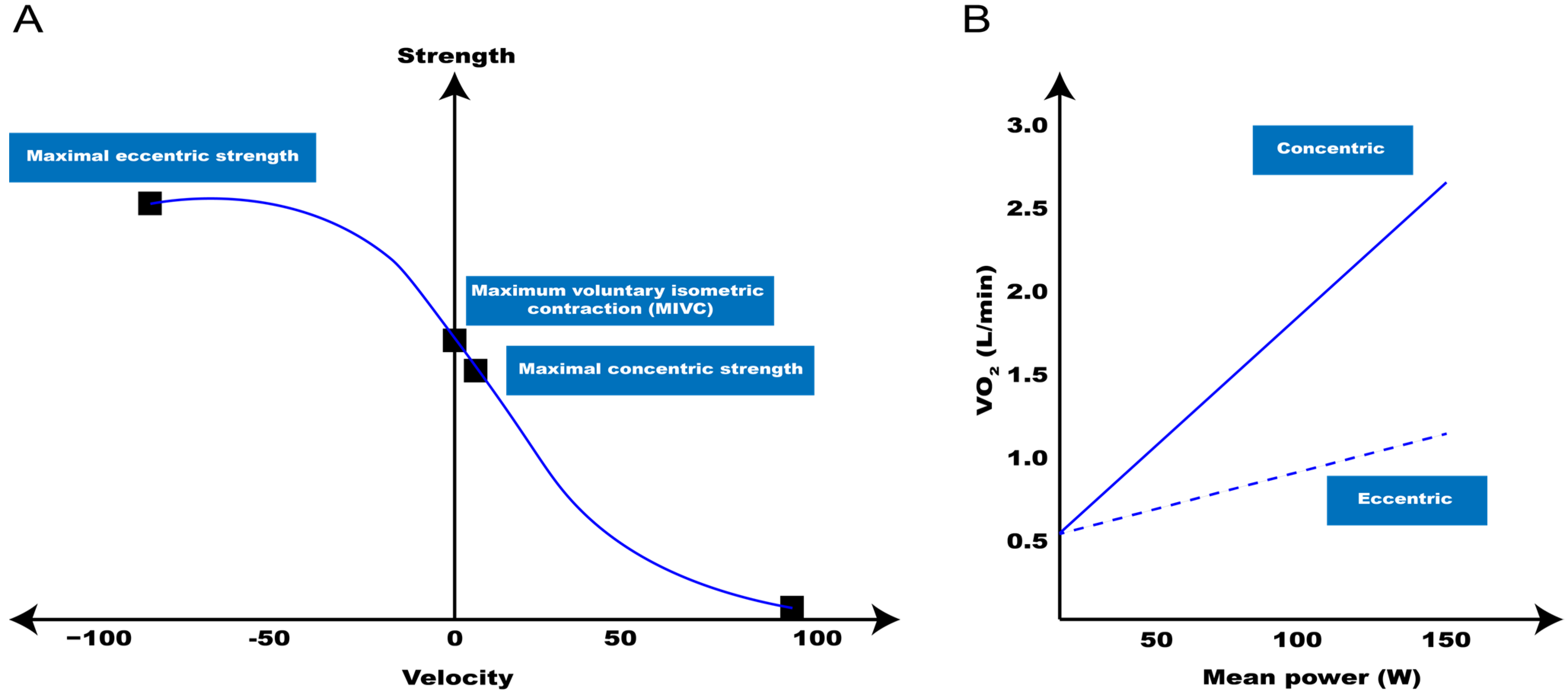

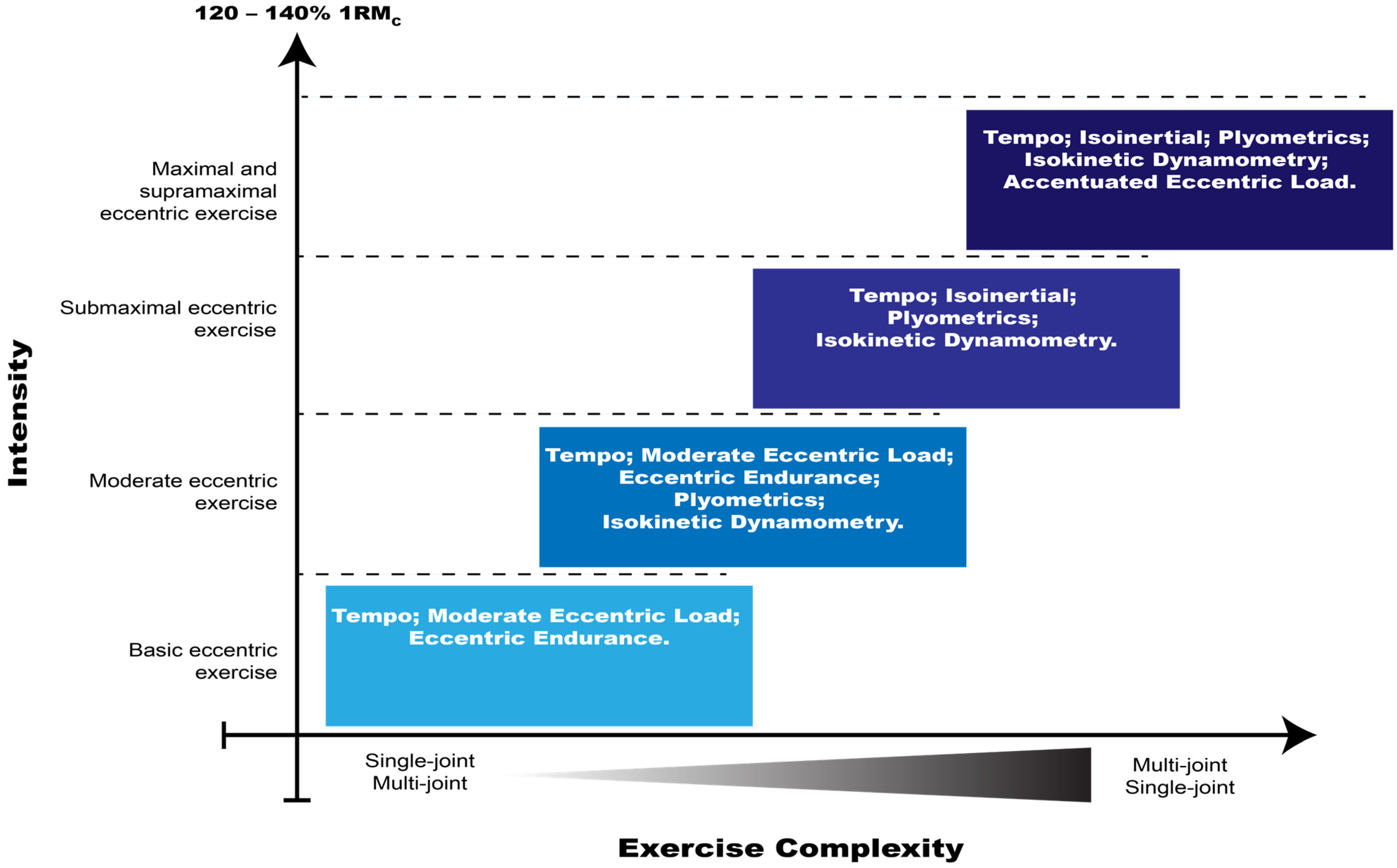

| Eccentric Exercise Classification | Eccentric Training Methods | Eccentric Training Purposes | Example |
|---|---|---|---|
| Basic eccentric exercise | Tempo; Moderate Eccentric Load; Eccentric Endurance. | Sports Rehabilitation and Return to Sport; Muscle Development; Injury Prevention; Special Populations. |  |
| Moderate eccentric exercise | Tempo; Moderate Eccentric Load; Eccentric Endurance; Plyometrics; Isokinetic Dynamometry. | Sports Rehabilitation and Return to Sport; Muscle Development; Injury Prevention; Special Populations; Sporting Performance. | 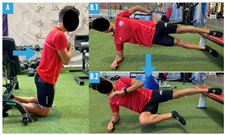 |
| Submaximal eccentric exercise | Tempo; Isoinertial; Plyometrics; Isokinetic Dynamometry. | Sports Rehabilitation and Return to Sport; Muscle Development; Injury Prevention; Special Populations; Sporting Performance. |  |
| Maximal and supra-maximal eccentric exercise | Tempo; Isoinertial; Plyometrics; Isokinetic Dynamometry; Accentuated Eccentric Load. | Sporting Performance; Muscle Development | 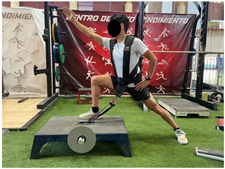 |
Disclaimer/Publisher’s Note: The statements, opinions and data contained in all publications are solely those of the individual author(s) and contributor(s) and not of MDPI and/or the editor(s). MDPI and/or the editor(s) disclaim responsibility for any injury to people or property resulting from any ideas, methods, instructions or products referred to in the content. |
© 2023 by the authors. Licensee MDPI, Basel, Switzerland. This article is an open access article distributed under the terms and conditions of the Creative Commons Attribution (CC BY) license (https://creativecommons.org/licenses/by/4.0/).
Share and Cite
Burgos-Jara, C.; Cerda-Kohler, H.; Aedo-Muñoz, E.; Miarka, B. Eccentric Resistance Training: A Methodological Proposal of Eccentric Muscle Exercise Classification Based on Exercise Complexity, Training Objectives, Methods, and Intensity. Appl. Sci. 2023, 13, 7969. https://doi.org/10.3390/app13137969
Burgos-Jara C, Cerda-Kohler H, Aedo-Muñoz E, Miarka B. Eccentric Resistance Training: A Methodological Proposal of Eccentric Muscle Exercise Classification Based on Exercise Complexity, Training Objectives, Methods, and Intensity. Applied Sciences. 2023; 13(13):7969. https://doi.org/10.3390/app13137969
Chicago/Turabian StyleBurgos-Jara, Carlos, Hugo Cerda-Kohler, Esteban Aedo-Muñoz, and Bianca Miarka. 2023. "Eccentric Resistance Training: A Methodological Proposal of Eccentric Muscle Exercise Classification Based on Exercise Complexity, Training Objectives, Methods, and Intensity" Applied Sciences 13, no. 13: 7969. https://doi.org/10.3390/app13137969
APA StyleBurgos-Jara, C., Cerda-Kohler, H., Aedo-Muñoz, E., & Miarka, B. (2023). Eccentric Resistance Training: A Methodological Proposal of Eccentric Muscle Exercise Classification Based on Exercise Complexity, Training Objectives, Methods, and Intensity. Applied Sciences, 13(13), 7969. https://doi.org/10.3390/app13137969






